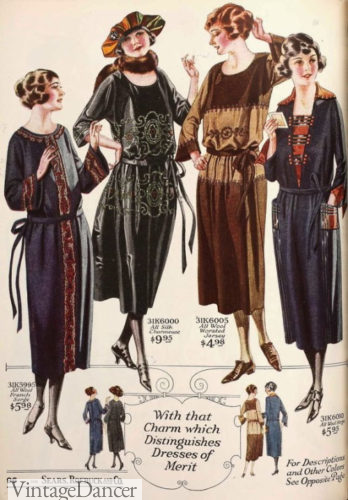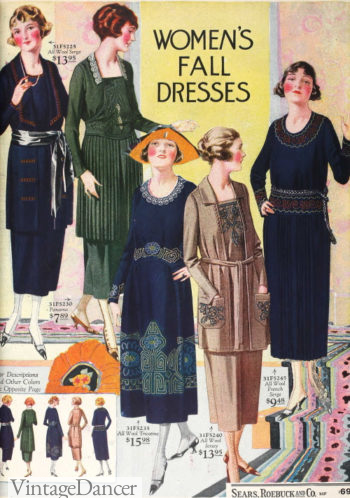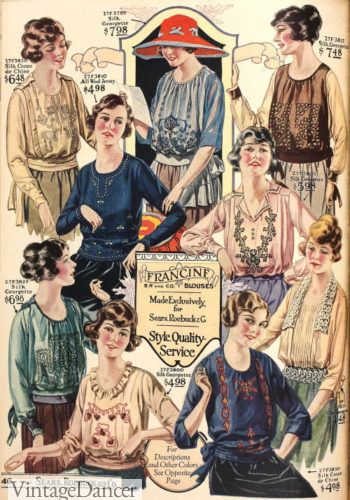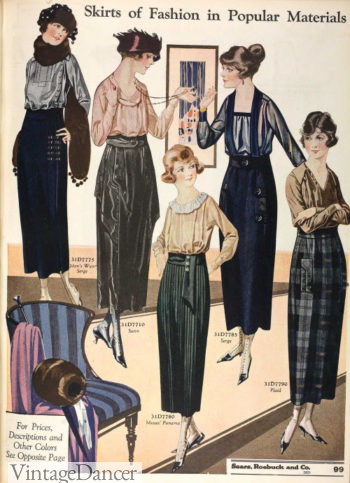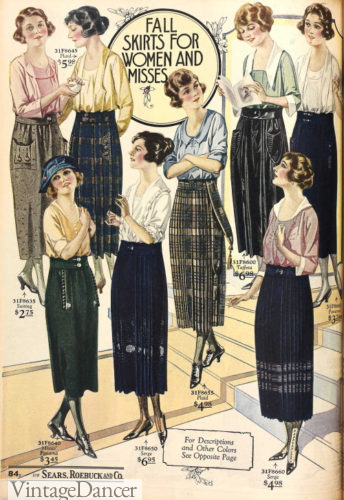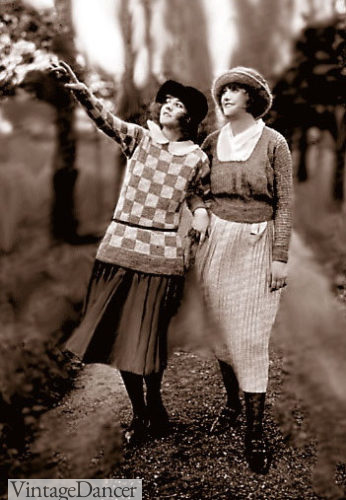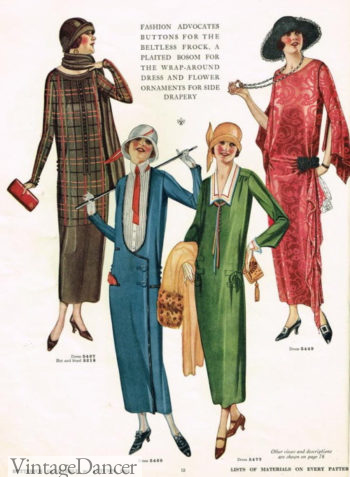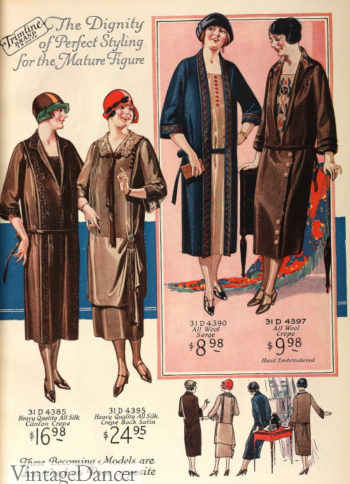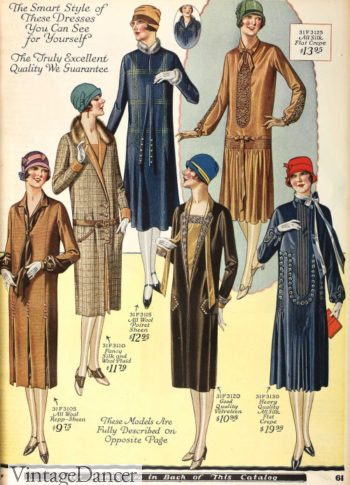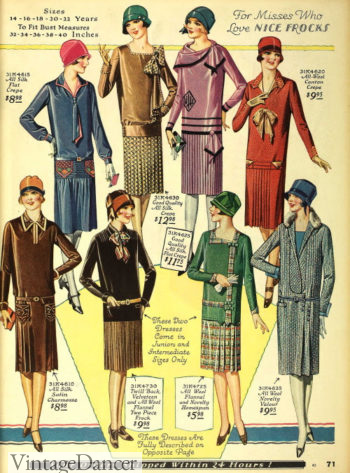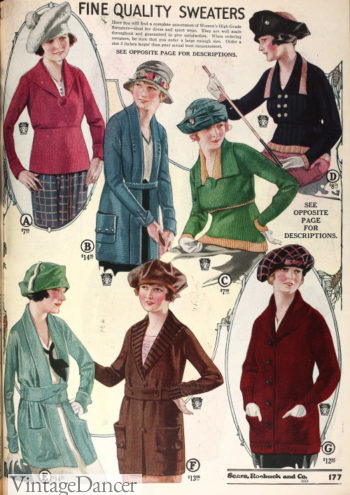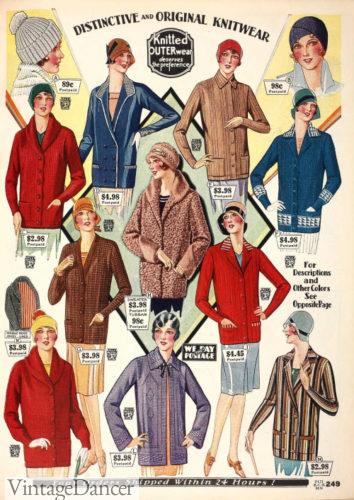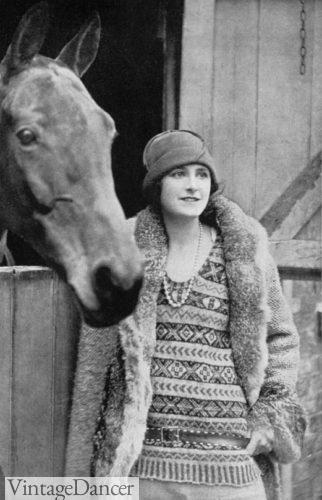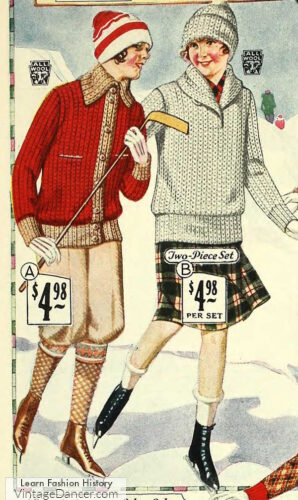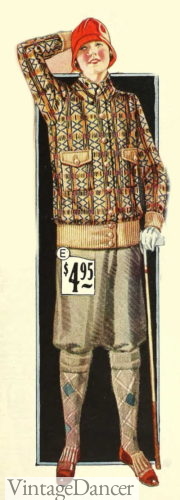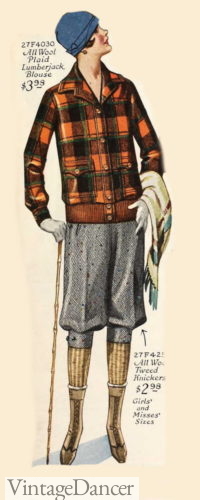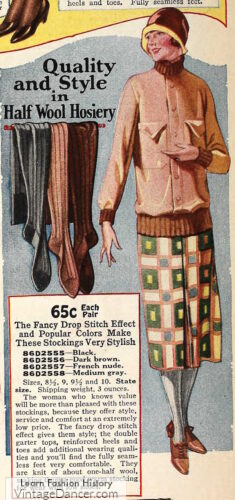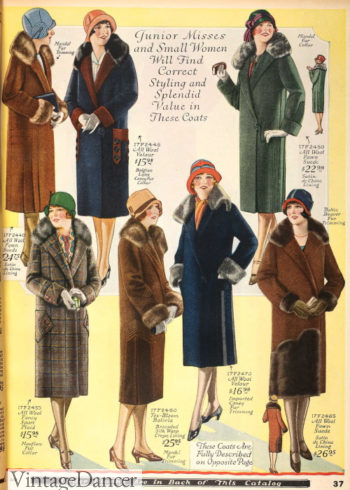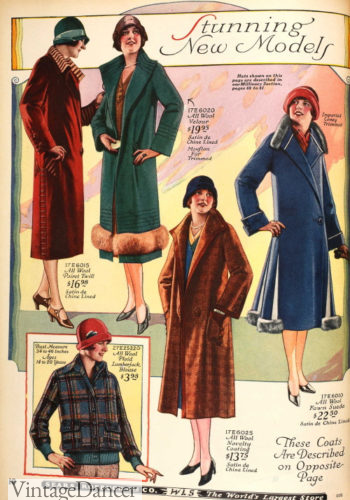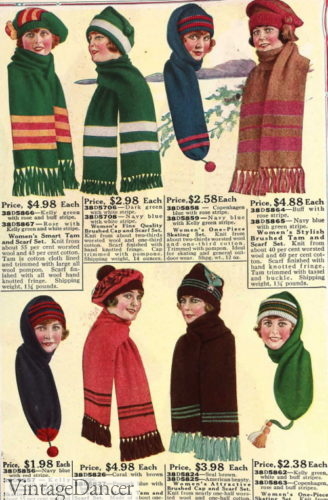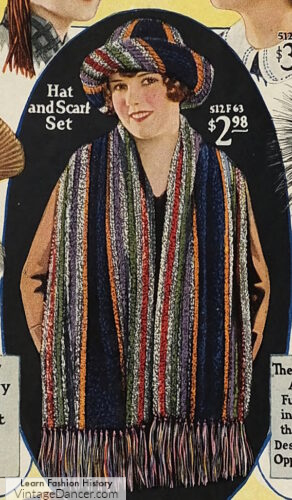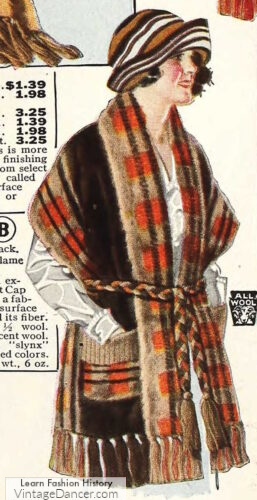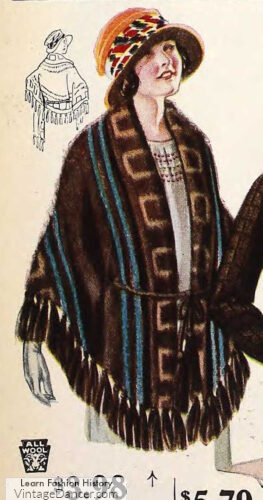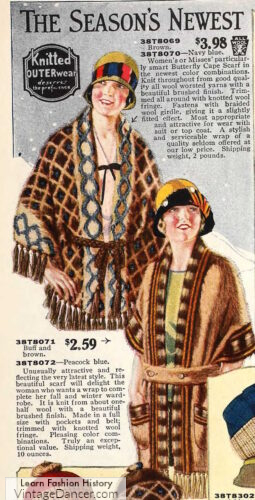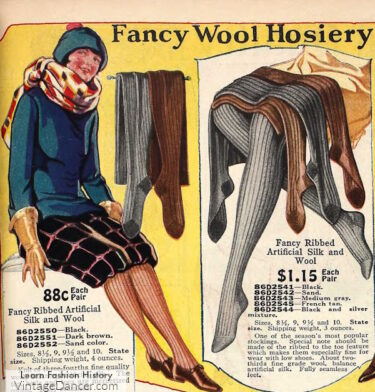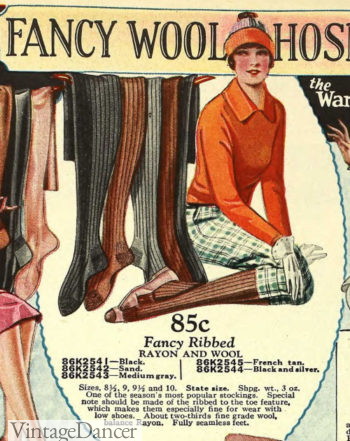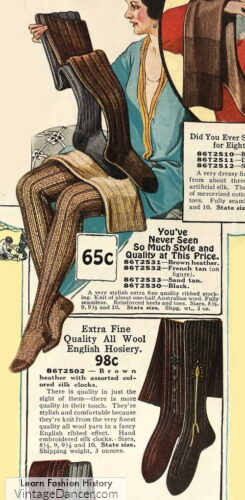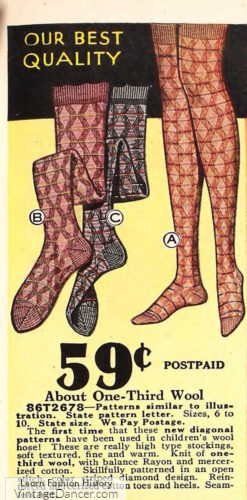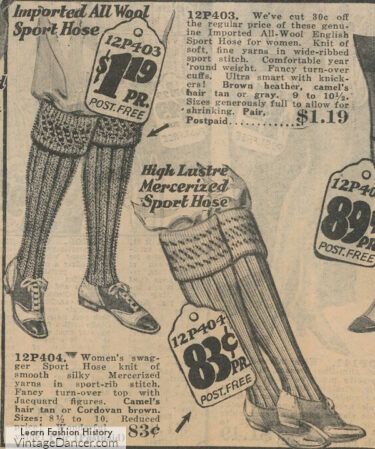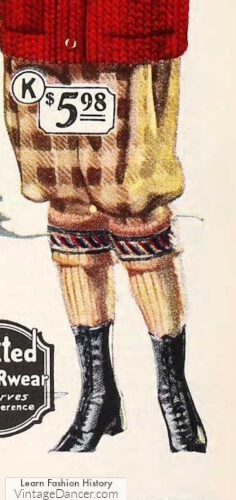Reader Maria wrote to me asking about 1920s winter fashion that is warmer than the typical short “flapper” dresses. With the exception of thick wool and wool overcoats, 1920s clothing in the fall and winter wasn’t very different than in the spring and summer.
1920s fall and autumn colors changed to cooler tones such as black, navy blue, burnt orange, olive green, and burgundy red, and sleeves were longer with higher necklines.
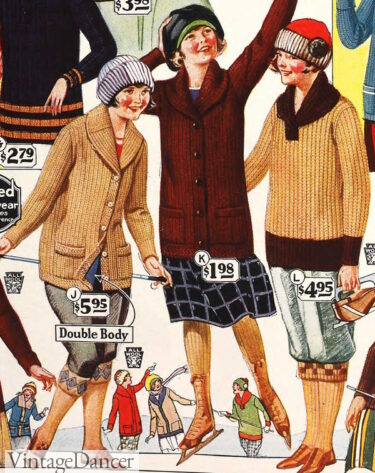
1925 girls snow plan clothes with breeches or skirt
Fabrics were often thicker cottons, wools, and velvet too but dress lengths did not change from season to season. To stay warm inside, women would wear thick cotton stockings and union suits underneath a dress. Warm coats, fur stoles, leather gloves and a fuzzy winter hat kept girls and woman warm when she was outside.
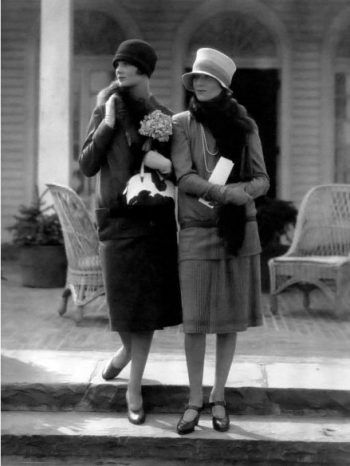
1926 warm suits topped with a fox fur stole
I gathered some pictures from my 1920s catalogs to show you some of the clothing women wore in the fall and winter followed by some tips on dressing in 1920s winter clothing today.
Follow the links to learn more about the 1920s clothing item or to shop for new 1920s inspired clothes.
1920s Winter Dresses
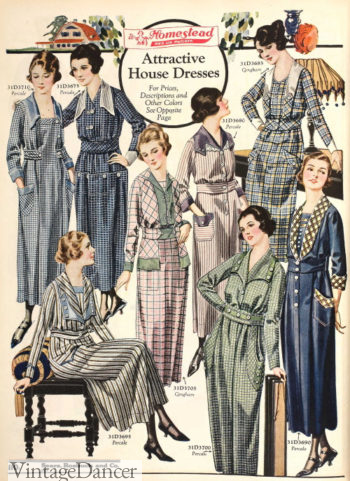
1920 house dresses, long sleeves, long lengths, comfortable flannel and cotton
1920 – The early ’20s still favored longer dresses year round. These ankle length house dresses with long sleeves, high necks, and muted winter colors are perfect for staying warm inside. Note the high button up boots on two of the ladies. This was a nice way to keep feet warmer. Wool spats also acted as shoe and ankle cover-ups.
- 1920 fall dresses
- 1921 fall winter dresses
1921 – More dresses from the same winter catalog. These are made from silk crepe de chine and all wool serge. Common winter colors in the early 20s: brown, burgundy, navy blue, and black. These suits form 1920 look very warm!
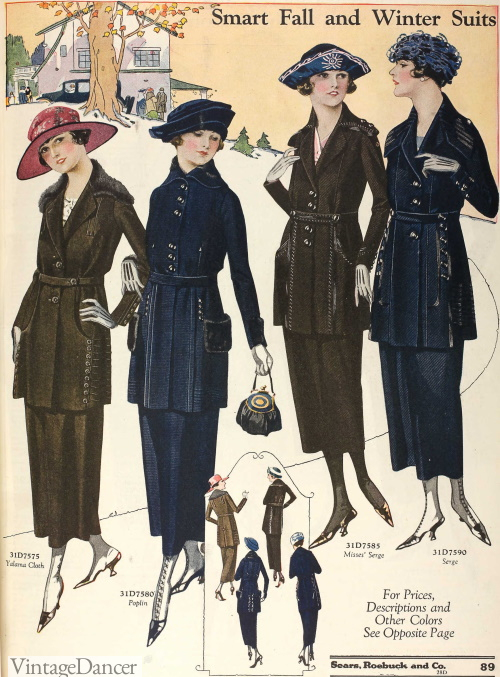
1920 women’s suits
1922 – Blouse and skirt combinations were a common alternative to house dresses. Midi blouses (sailor style) were made with heavier cotton for winter but in general was a sporty look that was avoided in winter.
Instead, blouses and tops changed colors from light pastels to heavier earth tones with heavier embroidery patterns to match. They were still quite sheer and not necessarily short sleeved. A warm camisole or two underneath and a cardigan sweater on top took the chill off.
- 1921 fall blouses
- 1920 skirts and blouses
- 1921 skirts and blouses
- 1922 checkered sweater and skirt- looks cozy!
1923: Long tunic dresses were similar to caftan/kaftan dresses. Also wrap over dresses. Long and slender, waistless shapes, you could layer warm long-johns underneath and be sufficiently dresses for outdoor winters. The One Hour Dress pattern is perfect for dresses made in this year. Choose brocade wool serge, wool crepe or velvet fabrics.
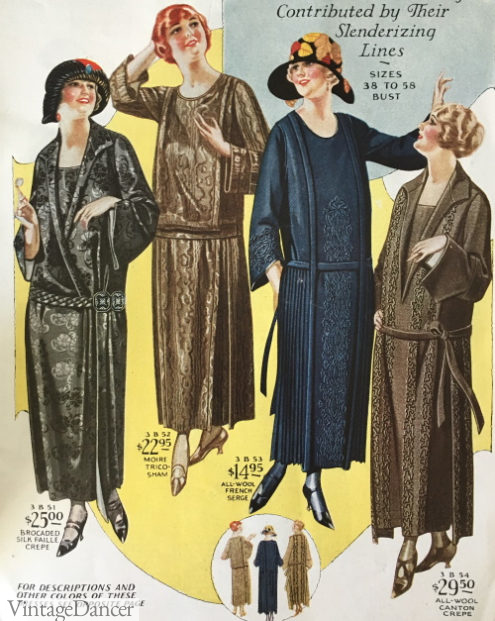
1923 plus size day dresses
1924: These coat dresses are fabulous (if you can find a pattern.)
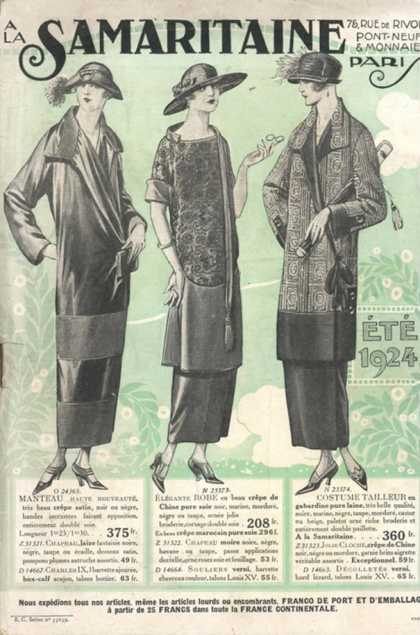
1924 Dress Coats – Another option of winter wear the coat and dress combo!
1925 – The last year that dresses were still long or “tea length” was 1924 and the winter of 1925. These charming day dresses for fall are still mostly short sleeved, with a changing color palette and darker trims. White collars were still popular year round, but now they were trimmed or lined in darker colors like navy blue or black. Dark sailor ties and belts, too, transitioned clothes from summer to fall.
- 1924 long tubular dresses
- 1925 loose belted dresses
1925 – Going to a party in the fall or winter didn’t mean fashion was dull. Bright cheerful colors like red and blue were found right alongside gold, silver and copper gowns. I just love the metal tones in evening wear during the 1920s. Notice, too, the long sleeves and matching jackets, capes, and scarves were a way to dress up a dress for winter. And the hats… just gotta love cloche hats made of velvet, wool, and felt in just as many colors as the dresses.
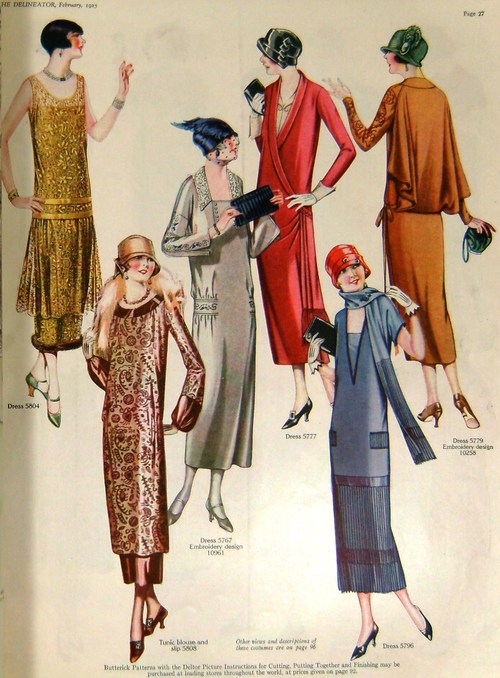
1925 Fall Fancy Dresses
1926-1927: Hemlines go up in 1926 to almost the knee exposed legs to cold temperatures. Besides thick stockings (or two pairs layered) adding a warm cloche hat, fur stoles and a coat will do well to keep your upper body warm.
- 1926 fall dresses and a coat
- 1927 daytime dresses
1928-1929 – Entering to the end of the 1920s, we see dress lengths did finally go up to the knee, even in winter. Pleats and tiered skirts were popular details during the later years, which in winter also worked in favor of adding more fabric to dresses. Thick flat crepe, wool, and flannel were all materials easy to pleat into the latest styles.
Notice, too, that instead of sheer insets, solid brown fabric insets alluded to bare skin yet revealed none. A sneaky way of being sexy and bundled up at the same time!
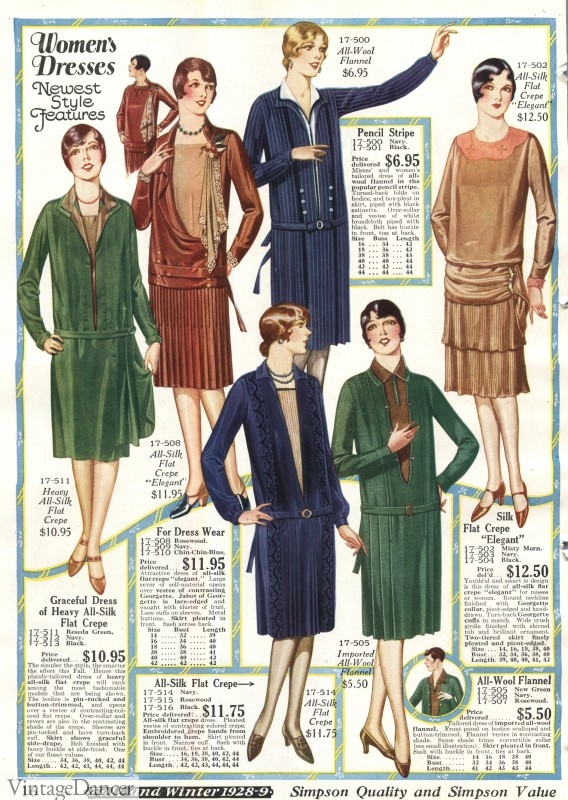
1928 Winter Dresses
1920s Sweaters & Jackets
A warm and cozy sweater was a winter necessity. They could be worn over dresses or with separates such as a skirt and blouse. Early 20s sweaters could be pullover, but most were long button up cardigans with a button or tie belt. Collars were wide that could be button up close to the neck or left open. Big pockets provided a place to keep hands warm or hold a pair of mittens.
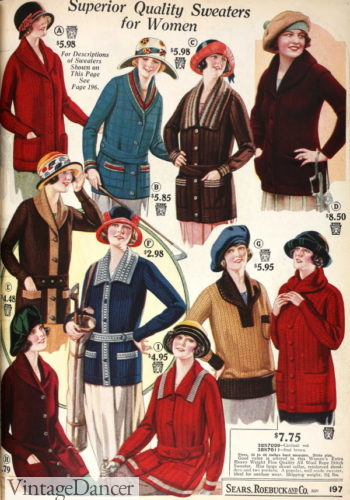
1923 sweaters and cardigans
Later ’20s sweaters exploded with new bold patterns such as Argyle, checks, florals, and wide stripes. Both button-up and pull over sweaters were popular from winter to spring. They looked sporty and casual. Pair them with a warm beret hat, wool cloche, or knit cap for layers of coziness.
1920s cas Read more about the history of Ladies’ Colorful 1920s Sweaters and Cardigans.
- 1920 sweaters and cardigans
- 1929 knit tops and sweaters, blazer jackets
- 1927 Lady Dunn wearing a Fair Isle sweater.
- 1927 sweaters with sporty togs
With sporty casual 1920s outfits came the need for a mid weight jacket. In the 1920s women’s jackets were called Lumberjack blouse or Windbreakers. Almost always plaid with knitted cuffs and collar, buttons up the front and two large flap pockets.
Women’s 1920s jackets were worn over shirts (blouses) and sweaters and paired with either wool knicker short pants or wool skirts.
- 1927 patterned jacket
- 1926 plaid jacket
- 1925 jacket and skirt
A dressier alternative jacket was a hip length fur, velvet or leather coat. By the 1930s the mens-style leather jacket was in vogue thanks to female Aviators making headlines.
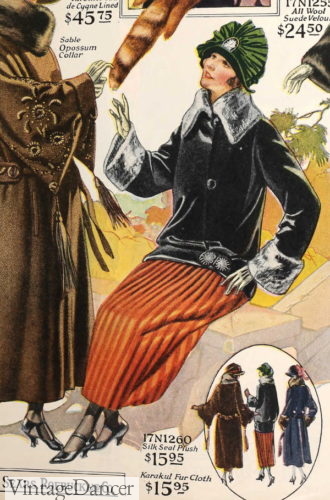
1923 leather jacket with pleated skirt
1920s Coats
A winter coat was another 1920s cold-weather essential.
Early 1920s winter coats had big round neck collars, belts, and big pockets. Later 20s coats featured the cocoon shape with a wrap front design fastened low on the hip with a big button. There was also the Trench coat style for both cold and rainy seasons.
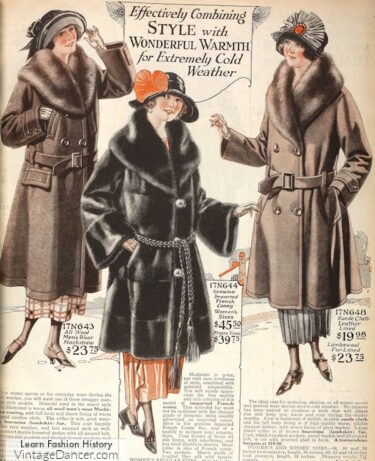
1923 women trench coat fur collars
Warmer winter coats often had big roll collars of fur. I love the bright colors – orange, peach, pink, green as well as the usual dark navy, brown and green.
Read about 1920s winter coats and jackets.
- 1926 coats fur collars
- 1926 coats and jacket
1920s Winter Hats
Contemporary fashions don’t know the value of a warm winter hat that is also stylish like those of the 1920s. Hats made of velvet, wool, cashmere, fur or knits made up the bulk of ’20s winter hats.
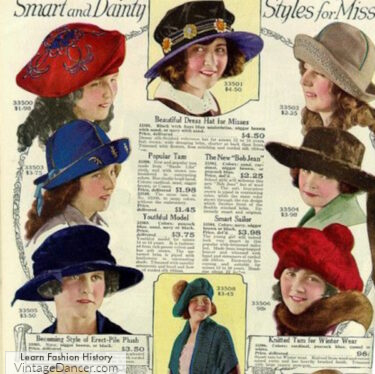
1922 winter hats- Tams and wide brim hats
A personal favorite winter hat in the rolled brim cloche or bucket hat. When made of brushed faux fur in looks very cozy!
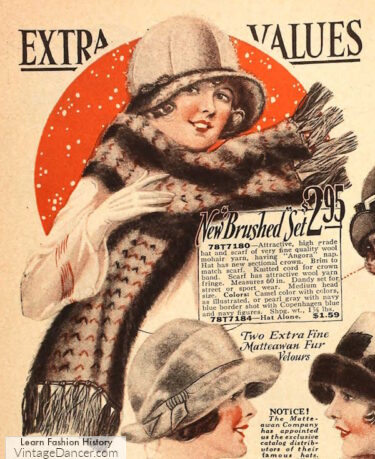
1924 brushed fur cloche hat and bucket hat
Wide brim hats in the early 1920s years were alternated with smaller toques, berets and beanie caps.
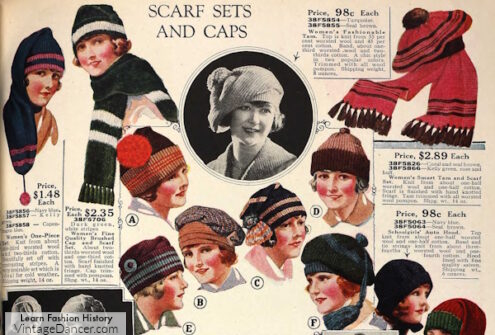
1921 beanie knit caps and Tams
The Tam O Shanter was a trendy hat in the early 20s. It’s like an oversized floppy beret with pom pom top.
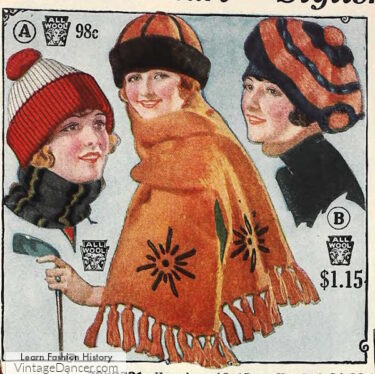
1922 beanie, fur hat and Tam ‘O Shanter
The all wool cloche with deep sides proved to be a very winter friendly hat in the later years. Cloches and turbans were draped in heavy fabrics and accented with fur poofs, dripping feathers and decorative embroidery.
Learn more about 1920s winter hats.
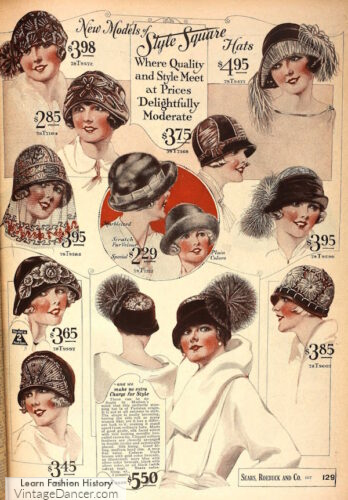
1924 fur and velvet winter hats
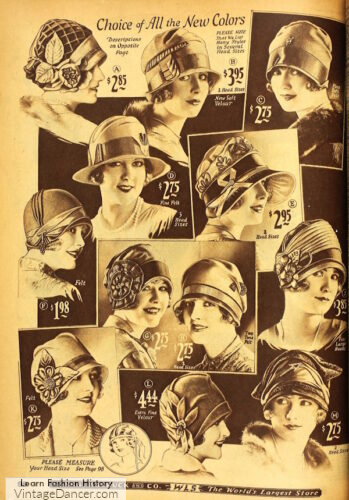
1927 winter hats- cloche hats and draped turbans
1920s Winter Scarves & Wraps
Women’s winter-weight 1920 scarves were called mufflers. 1920s winter scarves shortened up to waist length by the mid ’20s but grew very wide, almost shawl like, and were now made with lighter knits than the previous decade.
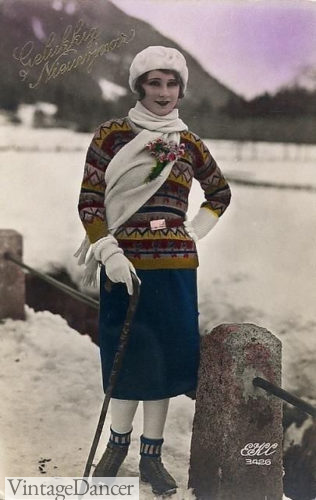
1920 hat, scarf, fair isle sweater, wool skirt, stockings and boots
The trend for brushed mohair wool gave scarves in the first half of the decade a “Rabbit hair” fuzzy texture that matched fuzzy hats. Smooth knits took over in the second half of the decade until 1928 when nearly all winter scarves disappeared. Women were now only wearing a colorful silk scarf tucked into a fur collar coat to keep their necks warm.
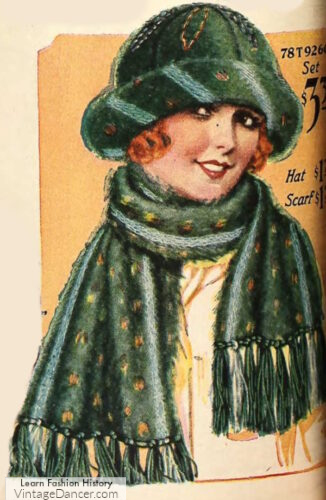
1924 brushed knit scarf and hat with embroidery
Besides texture the other detail of 1920s winter scarves were the fringe. Long fringe tipped the edges of scarves. In the Late teens and very early 20s some of these fringes were knotted like a tassel or replaced with a pom pom ball. So cute! But for most of the decade 4-8 inch long fringe edged most scarves.
- 1920 scarves and hats
- 1923 stiped neck scarf
Plaid was a common print, as well as vertical stripes in multiple colors, checkerboard in the early 20s, and geometric squares and stripes in the late 20s.
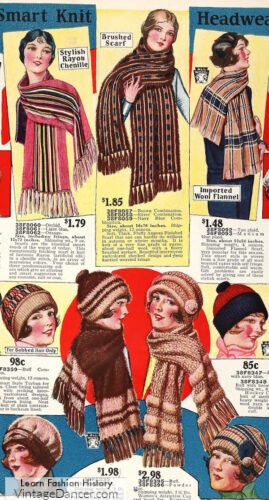
1926 scarves
Pastel colors were seen in the early 20s for the girlish look- rose-pink, teal, white as well as gem tones- red, kelly green and navy blue. The mid 20s favored shades of brown and tan with pops or peacock blue or red.
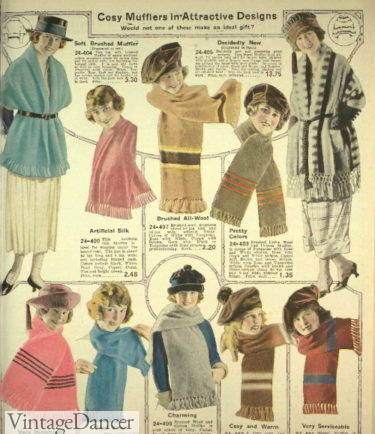
1921 winter scarves
The width of a 1920s scarf came in 3 options throughout the 1920s.
- Neck scarves varied: 16 by 76, 12 by 24, and 12 by 72 inches with about 4-6 inches of fringe included.
- Shawlette was 24-60 inches
- Square or rectangle silk scarves- 33 x 34 or 18 x 56 inches. See more about silk scarves.
1920s Winter Shawls
The shawlette and butterfly scarf were oversized, wide scarves that nearly turned into shawls and capes. They reached down to the mid back before being belted at the waist with a rope or braid tie. They were worn over blouses, dresses and light sweaters, mostly around the home or in the fall and spring when a heavy coat was not needed.
- 1922 Shawlette brushed knit scarf
- 1923 Butterfly scarf
- 1924 Shawlette and Butterfly scarves
Full length shawls in the 1920s were hand knitted wraps with long fringe. They could also be made of blanket cloth in plaid and stripe patterns. The most common fabric however, was Beaver cloth. Don’t worry, no actual Beavers were used. The wool-cotton blended heavy cloth had a napped surface giving it the look of Beaver fur. Many Beaver shawls featured a border design.
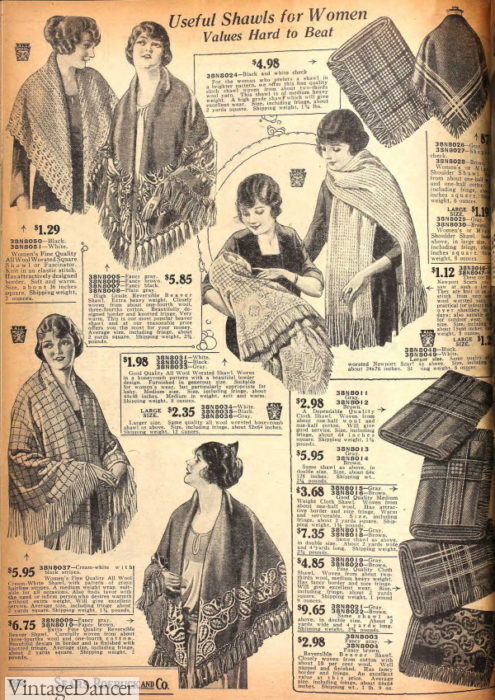
1923 knit shawls, beaver cloth shawls and plaid Blanket cloth shawls
1920s Fur stoles
Partly for warmth but mostly for showing off wealth, was the fur stole. Fox fur stoles with the head and feet attached were the most desired. They were wrapped around necks or draped off one shoulder over dresses, suits and coats.
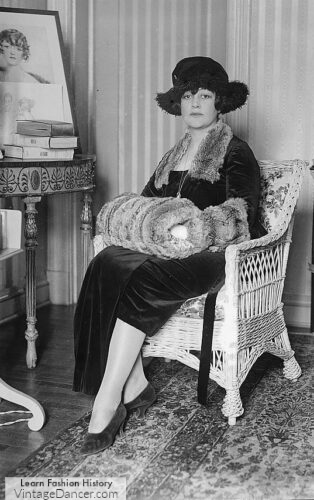
1921 Mrs. Louise Cromwell Brooks wearing a fur collar on her velvet dress holding a fur muff.
Other real and fake furs were used to make stoles, scarves, neck and head muffs.
1920s Winter Gloves and Mittens
Most ladies gloves for all season were soft kidskin leather or suede dress gloves in basic colors- fawn (tan), grey, brown and black. Some trends for colored gloves made red, purple, and white appear in fashion for a year or two.
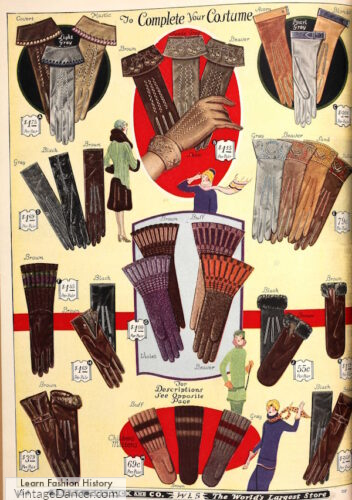
1926 winter gloves
Ladies winter gloves could be lined in mohair, fleece, or rabbit fur. May had decorated cuffs with embroidered patterns.
Knitted mittens and gloves were plain in color-blue, black, brown, and purple. Most had a longer mid-arm length or a wide gauntlet cuff.
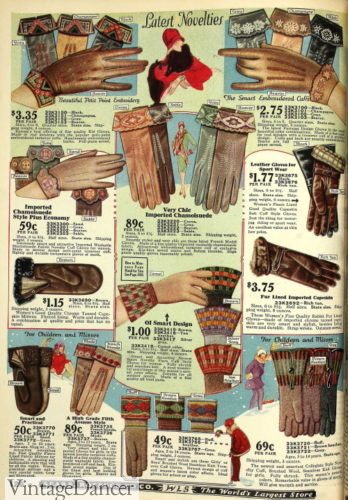
1927 winter gloves
Learn more about vintage gloves history.
1920s Winter Stockings and Socks
Keeping legs warm was critical to winter comfort in the 1920s, especially since women were still not allowed to wear long pants. Light silk stockings in summer were replaced by heavy knit wool stockings in winter. These could be made of smooth wool, soft cashmere wool, lighter wool-silks blends and heavy cotton.
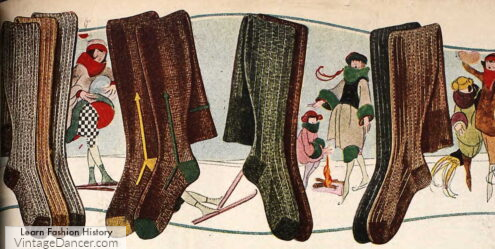
1922 wool stockings- clocked and heathered
Unlike summer when silk stockings were matched to skin tones in winter stockings were designed to be noticed. Ribbed textures were a favorite in shades of tan, brown, grey and black. Some still had clocked embroidery on the sides (a quickly fading trend.)
- 1925 ribbed silk-wool stockings
- 1927 wool ribbed winter stockings
For sporty looks the heather stocking and geometric patterns were paired with knicker pants and winter skirts. Colors were still mostly brown tones for cleanliness but the patterns made them fun to wear. Children especially liked patterned stockings but young women wore them too.
- 1924 heather wool stockings
- 1929 patterned stockings for sportswear
For extra warmth, some stockings were lined in fleece but most of the time on bitter cold days, women layered two stockings together.
For sporty gals and casual days playing in the snow, girls and women would put on a pair of sport hose aka golf socks. These tall socks with a wide cuff under the knee were worn with knickers and breeches. They could be layered over plain stockings or worn alone. The patterns on sport socks are very fun!
- 1924 sport hose with cuffs
- 1924 sport hose
Besides stockings and socks, women had more choices for leg coverings that we don’t see much of today. Leggings looked like tall spats that buttoned up the leg or were pull on knitted leggings with a shoe covering. They often came up high over the knee but could also be short under the knee leggings.
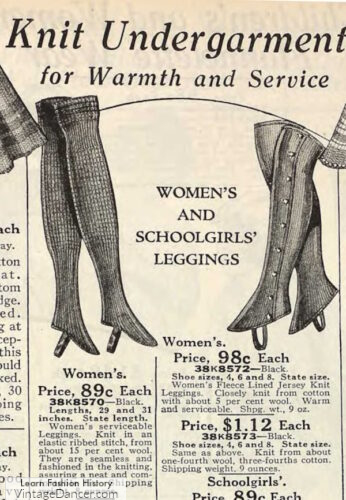
1922 knit and button leggings
Plain back jersey cloth leggings were the most common but some women had fun picking out sporty colors and patterns. They seem to be more common in Europe than America.
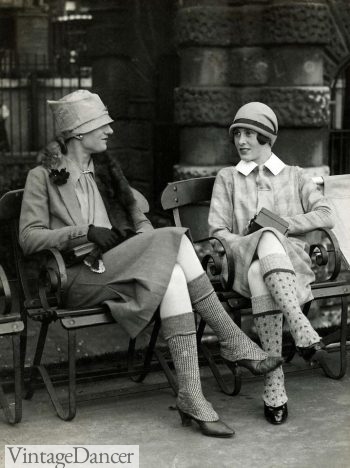
1926 ladies wearing short leggings with cuffs
1920s Winter Boots
Boots were worn when it was very wet and for snowy weather. Lace-up granny boots were the timeless winter boot style. They were often lined in shearling wool.
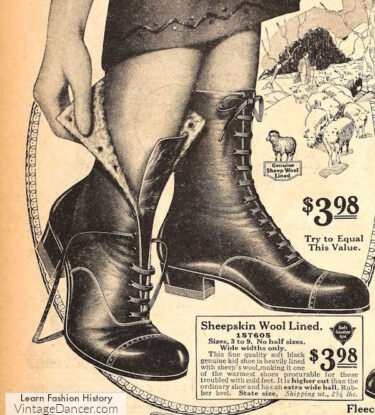
1924 lace up boots lined in shearling
A mid calf lace up boot with a buckle strap around the calf was called a storm boot, designed to keep snow out of the top.
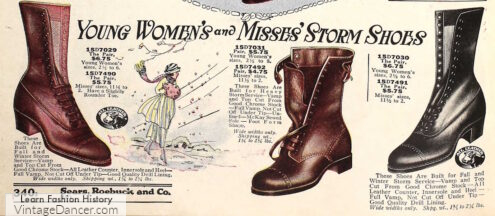
1920 lace up winter boots, storm boots (center)
Over the calf height lace up boots with a moccasin toe were worn as sporting and hiking boots as well as snow boots in winter.
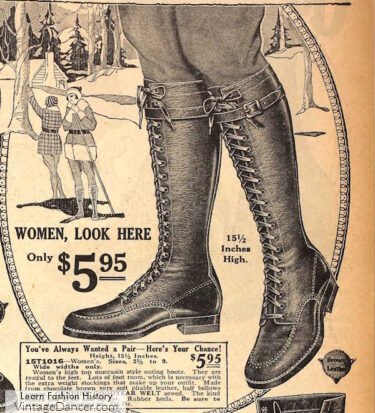
1924 tall boots for sportswear
Rubber boots and overshoes called Arctics or galoshes with big buckles worn undone gave a flap flap flap sound that might have contributed to the “flapper” name. They were quickly removed inside and replaced with nicer heels or Oxford shoes.
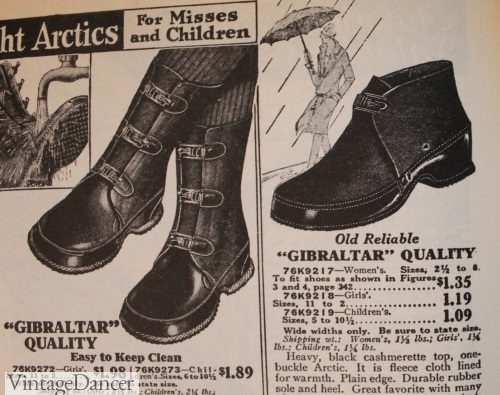
1920s galoshes- full boots or half boots
The bulk galoshes were replaced by daintier zip up or buckle overboots in the late 1920s. They came in felt wool or warmth or rubber for rain and snow.
There were also rubbed rain shoes that slipped on over heels. Read more about vintage rain and snow winter boots.
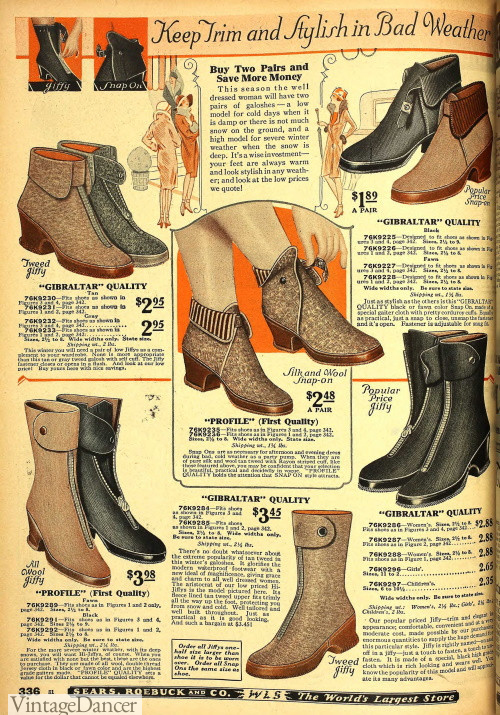
1927 rain boots, galoshes, overshoes
One final boot trend was the Russian boot, a step in mid calf boot with wide cuff. It was trendy in the early 1920s although not necessarily a warm winter boot it was more fashionable than lace up storm boots.
Lear about women’s 1920s shoe and boot styles.
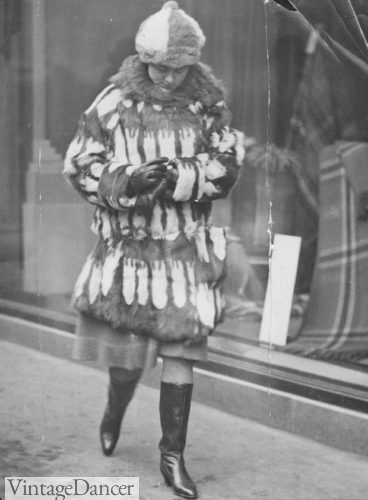
1925 fur winter coat and Russian boots
Tips for dressing winter 1920s fashion
-
- Look for long velvet, wool or heavy cotton straight fitting dresses with long sleeves and a high neck. Some options here or sew a dress from a pattern.
- Long straight winter coats made of wool with a fur collar are not as easy to find as you would think. A cocoon shape is the best but even harder to find. Shop coats.
- When you can’t find a matching jacket, a contrasting silk, lace or fringe shawl (the bigger the better) is perfect as well as fur (or faux fur) wraps, stoles, and collars.
- Long skirts paired with a long sweater and warm blouse underneath is another good outfit.
- Wide leg pants and a sweater or short jacket isn’t 100% accurate, but certainly more practical. I look to ’20s menswear for gender-bending ideas.
- Knicker pants with tall Scottish socks are more accurate in the 1920s. I own a pair in corduroy.
- A warm wool cloche is a great choice for hats. I like knit berets, velvet bucket hats and turbans, too. For very cold but casual dressing, a knit beanie cap and scarf is timeless.
- Don’t forget boots. Lace-up boots or rubber rain boots are a must.
- Don’t forget wool or cotton tights (ice skating tights are very warm).
- Underwear too can help keep you warm. Consider knitted slips and long bloomer panties.
Here are some outfits I have worn or would wear for a 20s winter look
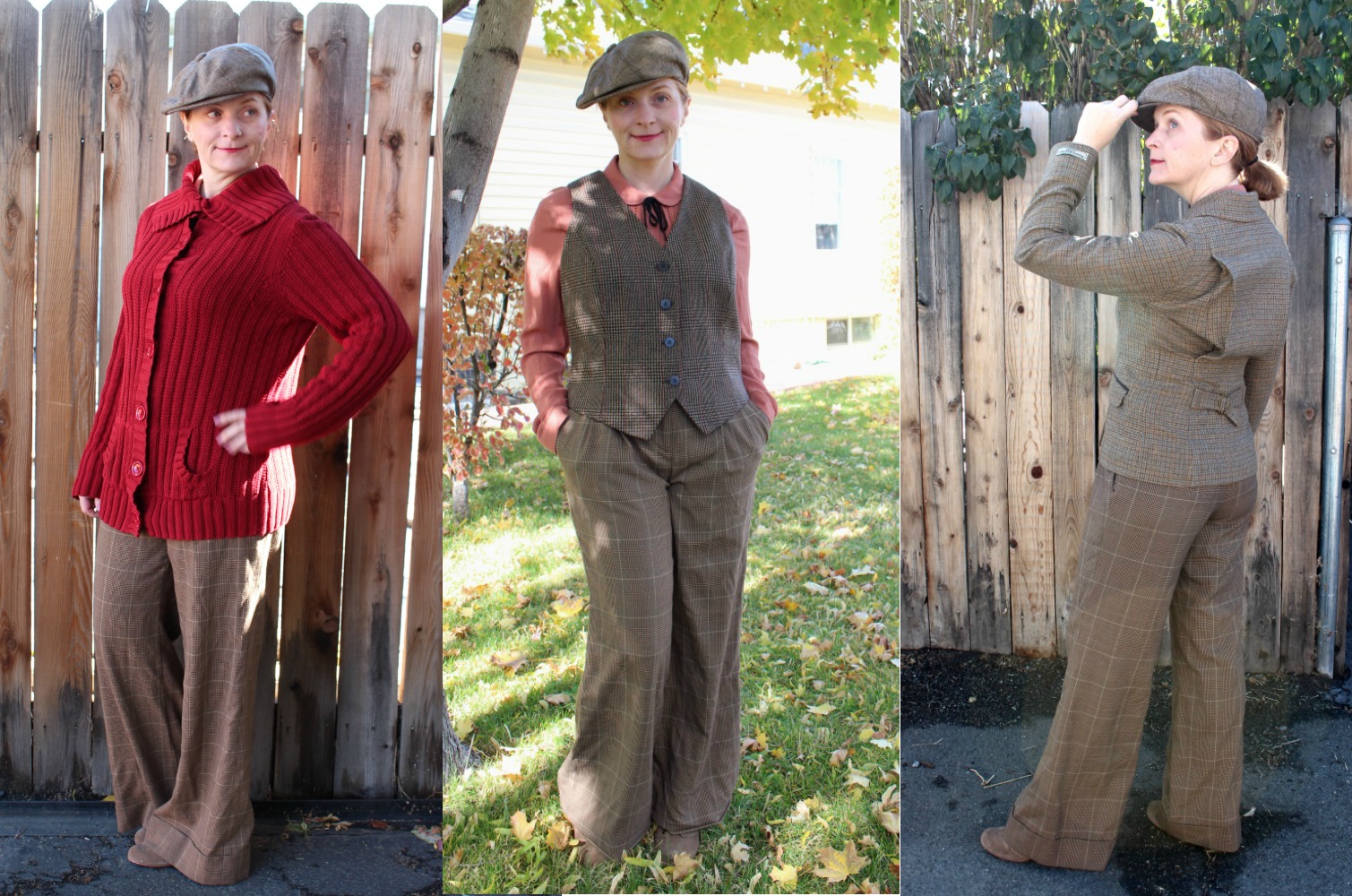
1920s casual menswear for women sporty clothing ideas. See more
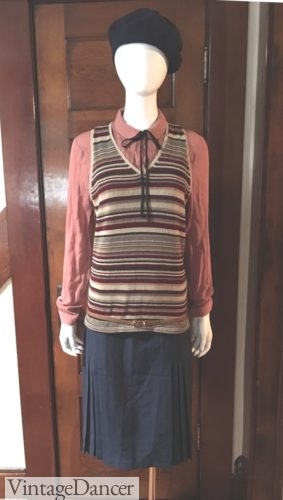
A casual, sporty 20s skirt, blouse, vest and beret hat. Winter or spring!
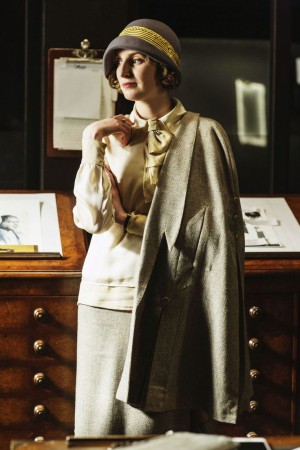
A tweed wool suit in the 20s style is on my bucket list.
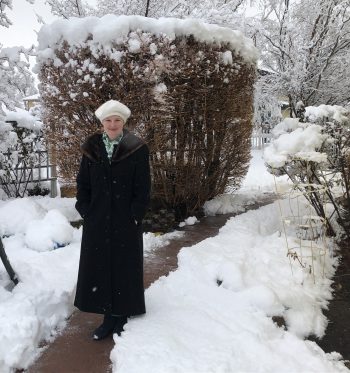
A winter coat, scarf and beret hat plus boots complete this snow friendly outfit
Debbie Sessions has been teaching fashion history and helping people dress for vintage themed events since 2009. She has turned a hobby into VintageDancer.com with hundreds of well researched articles and hand picked links to vintage inspired clothing online. She aims to make dressing accurately (or not) an affordable option for all. Oh, and she dances too.
